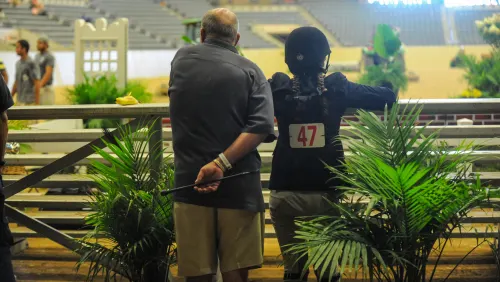Since we’re coming to the end of the year, several people have requested that I write about three subjects that are near and dear to them and to me. It’s always nice to know that my columns are getting people thinking and talking.
The first topic is the junior handy hunter courses that always cause so much controversy at shows. Show managers and especially course designers simply have to give these classes the thought and time they deserve. I was on the USEF Junior Hunter Committee when we voted to make this a mandatory part of the five classes required at AA-rated shows. The committee’s intention was to have a class that allowed riders to show off their skills and to have something that was different for the judges to judge and for people to watch.
At Devon (Pa.), the working handy class is always so popular because it’s so much fun to watch. This year the handy classes at Capital Challenge (Md.)
and Washington (D.C.) for the working division were also top classes, with great horses and riders trying to out-turn the previous rider.
The course designers must set courses that have options to do inside turns or to dare to take an unusual track. The judges must start to judge these classes as “handy” classes and start to reward the riders who do those turns, who take those chances. Too many times I see riders go way wide on turns and do nothing to make their round handy at all–and they still win.
Show managers should not put pressure on their course designers to make it a fast course with no options. That’s absolutely not the point of this class.
The Junior Hunter Committee has provided guidelines of requirements for the junior hunter handy classes. Maybe it would be more exciting if every division were required to have a handy class. You might recall that the international challenge handy hunter class at the FEI World Cup Final in Las Vegas last April was fantastic.
ADVERTISEMENT
And it was a class that the fans could really understand.
My second item for discussion is the pre-green horse. I think we trainers need to remember (or be reminded of) exactly what a pre-green horse is. Every zone has different specifications on how many years a horse can show in the pre-green division. That’s a problem, but even worse is people showing horses in it that they’ve brought from Europe, where they’ve been showing in the 1.4-meter (4’6″) classes. They shouldn’t be eligible for the pre-green division.
We professionals need to encourage people to move their horses into another division when they’re no longer pre-green. There are lots of choices.
A pre-green horse is in his first year of showing at a rated show. Two years is the longest those horses should show in that division.
My third topic is a pet peeve of mine–sportsmanship and horsemanship. I wrote an article about this subject two years ago and got quite the response.
It seems some of our sport’s most accomplished exhibitors want to act poorly. We wonder why, as the shows grow each year, we still don’t have the support of sponsors we’d like to have.
Well, here’s one reason: Teaching our children to wear shirts that are inappropriate toward another trainer.
And what about the clothes people wear into the ring at any show to accept an award? It’s time for show managers to set a dress code for award presentations, especially at our top shows! No more blue jeans and tank tops! Show the sponsors we really do care about these prestigious awards, that we will rise to the occasion.
ADVERTISEMENT
I’ve never seen Olympic or Samsung Super League pictures with the team riders in blue jeans and tank tops. It’s time to have our juniors and professionals start acting the part. Demonstrate to the show managers and sponsors that we want them to continue their hard work, that we appreciate it.
Why do most of our professionals walk into the ring with their boots so shiny they glare and our juniors could care less if the mud and dirt from the last show was still part of their attire?
Spruce Meadows in Alberta has the most sponsors of any show on this continent. And they have strict rules for accepting awards, rules that cause them to withhold your check if you don’t follow them. The sponsors feel as if they’re special and that their class is really a big deal for each ribbon winner.
When you go in the ring to accept an award, think about how the sponsor of that class perceives you. Will that sponsor be so impressed that they’ll be back next year? Or will they walk away saying, “Well, if they came into receive their award with a tank top and blue jeans, they must not care too much about my trophy or my check!”
But no one wants to take a stand–the parents, the owners, the trainers or the show managers. It’s the entire package that we need to look at–good sportsmanship, clean horses, clean tack and well turned-out riders. And how about a thank-you note to the people who sponsor some of these top classes?
One more thing: The U.S. Hunter Jumper Association convention took place in Miami, Fla., last week [to be reported in the Dec. 23 issue], and if you don’t like one or more of the rule-change proposals debated there but you weren’t there, then you better not complain. It’s up to you to get involved and to be at that convention or at the U.S. Equestrian Federation convention in January to express yourself.














